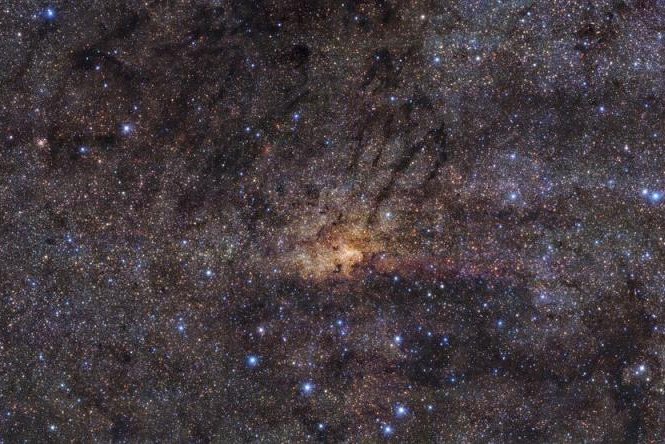Scientists used ESO's HAWK-I instrument on the Very Large Telescope to survey an expanse of the Milky Way's central disk measuring 60,000 square light-years and containing 3 million stars. Photo by Nogueras-Lara et al./ESO
Dec. 17 (UPI) -- Astronomers have discovered evidence that an intense period of stellar formation supplied the Milky Way with hundreds of thousands of massive stars beginning roughly 1 billion years ago.
Scientists made the discovery using the European Southern Observatory's Very Large Telescope, which successfully captured high-resolution images of a central part of the Milky Way known as the nuclear disk.
By studying the stars, gas and dust in unprecedented detail, scientists were able to confirm that the bulk of the central disk's stars, roughly 80 percent, formed between 13.5 billion and 8 billion years ago.
After the initial burst, the disk's rate of star formation dropped to near zero. For 6 billion years, few stars were born. But the latest research, published this week in the journal Nature Astronomy, suggests the dry spell ended with an outburst of stellar formation.
"Contrary to what had been accepted up to now, we found that the formation of stars has not been continuous," lead researcher Francisco Nogueras-Lara said in a news release.
Nogueras-Lara, who is now based at the Max Planck Institute for Astronomy in Heidelberg, Germany, led the study of the Milky Way's nuclear disk while at the Institute of Astrophysics of Andalusia in Granada, Spain.
The outburst described by Nogueras-Lara and his colleagues, which began 1 billion years ago and lasted 100 million years, yielded hundreds of thousands of massive stars. Because massive stars have comparatively shorter lifespan, the outburst eventually culminated in a rash of supernova explosions.
"This burst of activity, which must have resulted in the explosion of more than a hundred thousand supernovae, was probably one of the most energetic events in the whole history of the Milky Way," Nogueras-Lara said.
Today, just a one or two new stars are born in each year in the entirety of the Milky Way. The newest data, captured using ESO's HAWK-I instrument on the VLT in the Chilean Atacama Desert, suggests that rate was once dramatically greater.
"The conditions in the studied region during this burst of activity must have resembled those in 'starburst' galaxies, which form stars at rates of more than 100 solar masses per year," said Nogueras-Lara.















